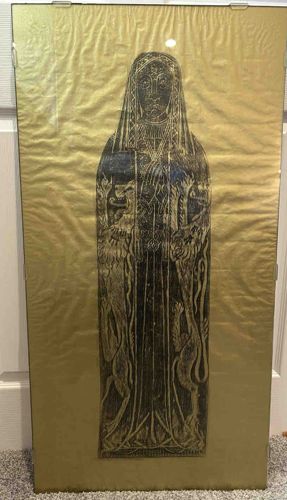
Medieval Clergyman or Noblewoman Brass Rubbing
This item is an original grave rubbing, depicting what appears to be a full-length effigy of a medieval clergyman or noblewoman. The rubbing is rendered in a dark, likely black or very dark brown, medium against a metallic gold-colored paper substrate, which has a distinct crinkled or textured finish, contributing to an aged and authentic aesthetic. The figure is depicted with a long, flowing garment, possibly a cassock or a medieval dress, and is adorned with a detailed head covering that drapes over the shoulders. The facial features are stylized, typical of medieval artistic conventions, showing a solemn expression. Notable features include intricate decorative elements that cover the body of the figure; these appear to be religious symbols or patterns, possibly including foliage or mythical beasts intertwined within the drapery. On either side of the figure's lower body, distinct animal figures, possibly lions or similar heraldic beasts, are visible, typically found supporting the feet of effigies. The overall condition of the rubbing suggests some handling and age, evidenced by the creases and slight unevenness in the gold paper, which might also be intentional to mimic antique parchment. There are no obvious tears or significant damage visible, though the reflective quality of the gold paper and lighting conditions make some details harder to discern. The impression is strong and clear, indicating a well-executed rubbing. The piece is currently displayed framed, under a protective covering (possibly acrylic or glass), held by contemporary clear clips at the top, suggesting it is a cherished and preserved artwork. This style of grave rubbing typically dates from the 19th or 20th century, replicating medieval monumental brasses, with the original brasses often dating from the 13th to 17th centuries in England and Europe. The craftsmanship is high, effectively capturing the detail of the original brass. The size of the rubbing suggests it depicts a life-sized or near life-sized effigy, making it a substantial piece of art.
AI-Generated Appraisal Disclaimer
Estimated Value
$250-450
Basic Information
Category
Art / Decorative Object
Appraised On
December 13, 2025
Estimated Value
$250-450
Additional Details Provided By Owner
User Provided Information
Original grave rubbing
Item Description
This item is an original grave rubbing, depicting what appears to be a full-length effigy of a medieval clergyman or noblewoman. The rubbing is rendered in a dark, likely black or very dark brown, medium against a metallic gold-colored paper substrate, which has a distinct crinkled or textured finish, contributing to an aged and authentic aesthetic. The figure is depicted with a long, flowing garment, possibly a cassock or a medieval dress, and is adorned with a detailed head covering that drapes over the shoulders. The facial features are stylized, typical of medieval artistic conventions, showing a solemn expression. Notable features include intricate decorative elements that cover the body of the figure; these appear to be religious symbols or patterns, possibly including foliage or mythical beasts intertwined within the drapery. On either side of the figure's lower body, distinct animal figures, possibly lions or similar heraldic beasts, are visible, typically found supporting the feet of effigies. The overall condition of the rubbing suggests some handling and age, evidenced by the creases and slight unevenness in the gold paper, which might also be intentional to mimic antique parchment. There are no obvious tears or significant damage visible, though the reflective quality of the gold paper and lighting conditions make some details harder to discern. The impression is strong and clear, indicating a well-executed rubbing. The piece is currently displayed framed, under a protective covering (possibly acrylic or glass), held by contemporary clear clips at the top, suggesting it is a cherished and preserved artwork. This style of grave rubbing typically dates from the 19th or 20th century, replicating medieval monumental brasses, with the original brasses often dating from the 13th to 17th centuries in England and Europe. The craftsmanship is high, effectively capturing the detail of the original brass. The size of the rubbing suggests it depicts a life-sized or near life-sized effigy, making it a substantial piece of art.
Get Your Items Appraised
Instant estimates of your treasures with AI-powered instant appraisals